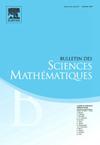Semi-hyponormality of commuting pairs of Hilbert space operators
IF 0.9
3区 数学
Q2 MATHEMATICS, APPLIED
引用次数: 0
Abstract
We first find an explicit formula for the square root of positive operator matrices with commuting entries, and then use it to define and study semi-hyponormality for commuting pairs of Hilbert space operators. For the well-known 3–parameter family of 2–variable weighted shifts, we completely identify the parametric regions in the open unit cube where is subnormal, hyponormal, semi-hyponormal, and weakly hyponormal. As a result, we describe in detail concrete sub-regions where each property holds. For instance, we identify the specific sub-region where weak hyponormality holds but semi-hyponormality does not hold, and vice versa. To accomplish this, we employ a new technique emanating from the homogeneous orthogonal decomposition of . The technique allows us to reduce the study of semi-hyponormality to positivity considerations of a sequence of scalar matrices. It also requires a specific formula for the square root of scalar and operator matrices, and we obtain that along the way. As an application of our main results, we show that the Drury-Arveson shift is not semi-hyponormal. Taken together, the new results offer a sharp contrast between the above-mentioned properties for unilateral weighted shifts and their 2–variable counterparts.
Hilbert空间算子交换对的半次反常
首先给出了具有可交换项的正2×2算子矩阵的平方根的显式公式,然后用它来定义和研究Hilbert空间算子的可交换对的半次反常。对于众所周知的2变量加权位移的3参数族W(α,β)(a,x,y),我们完全识别了开放单元立方体中W(α,β)(a,x,y)为次正规、次正规、半次正规和弱次正规的参数区域。因此,我们详细描述了每个属性所包含的具体子区域。例如,我们确定弱次反常存在但半次反常不存在的特定子区域,反之亦然。为了实现这一目标,我们采用了一种新的技术,该技术源自于l2 (Z+2)的齐次正交分解。该技术允许我们将半次反常的研究减少到2×2标量矩阵序列的正性考虑。它还需要一个特定的公式来求2×2标量和算子矩阵的平方根,我们在这个过程中得到了它。作为我们主要结果的一个应用,我们证明了Drury-Arveson位移不是半次异常。总的来说,新的结果提供了一个鲜明的对比,上述性质的单边加权位移和他们的2变量对应。
本文章由计算机程序翻译,如有差异,请以英文原文为准。
求助全文
约1分钟内获得全文
求助全文
来源期刊
CiteScore
1.90
自引率
7.70%
发文量
71
审稿时长
6-12 weeks
期刊介绍:
Founded in 1870, by Gaston Darboux, the Bulletin publishes original articles covering all branches of pure mathematics.

 求助内容:
求助内容: 应助结果提醒方式:
应助结果提醒方式:


